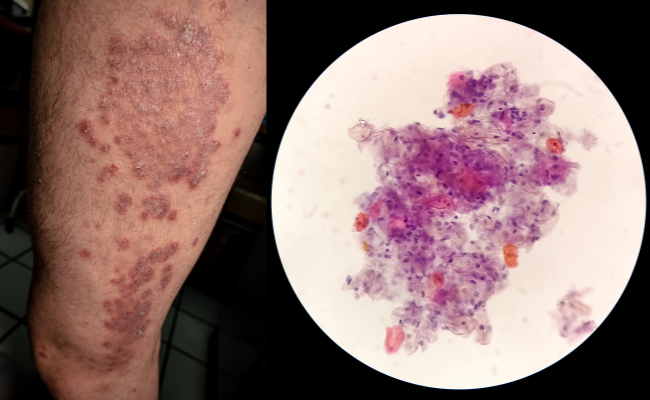How to Treat Lichen Sclerosus?
- February 06, 2024
- No Comments

What is Lichen Sclerosus?
Lichen sclerosus is characterized by thin, white patches of skin, mainly affecting the genital and anal areas, leading to discomfort, itching, and pain. If left untreated, persistent scratching can result in scarring and an elevated risk of skin cancer. Timely diagnosis and appropriate management are essential to alleviate symptoms and prevent complications, including dyspareunia and an increased susceptibility to cancer.
Why is Lichen Sclerosus Treatment Necessary?
Lichen sclerosus can have a significant impact on a person's quality of life due to symptoms such as itching, pain, and discomfort. Without proper treatment, the condition can worsen over time, leading to complications such as scarring, fusion of the genital or anal skin, and increased risk of skin cancer. Early intervention is crucial to alleviate symptoms, prevent complications, and improve overall well-being.
How to Treat Lichen Sclerosus
- Topical Corticosteroids: Topical corticosteroid creams or ointments are the mainstay of treatment for lichen sclerosus. These medications help reduce inflammation, itching, and discomfort associated with the condition. They are typically applied directly to the affected skin once or twice daily for a specified duration under the guidance of a healthcare professional. Topical corticosteroids can effectively control symptoms and may help prevent disease progression in many cases.
- Moisturizers: Regular use of moisturizing creams or emollients can help keep the skin hydrated and reduce dryness and itching associated with lichen sclerosus. Moisturizers should be applied liberally to the affected areas after bathing or showering to lock in moisture and soothe the skin. Emollients containing ingredients such as ceramides, glycerin, or petrolatum are particularly beneficial for dry, sensitive skin.
- Calcineurin Inhibitors: In cases where topical corticosteroids are not effective or suitable, calcineurin inhibitors such as tacrolimus or pimecrolimus may be prescribed. These medications work by suppressing the immune response and reducing inflammation in the skin. Calcineurin inhibitors are applied topically to the affected areas and may be used as an alternative or adjunctive therapy for lichen sclerosus.
- Surgery: In severe cases of lichen sclerosus with scarring or anatomical distortion, surgical intervention may be necessary to relieve symptoms and restore function. Surgical options may include circumcision (in men), vulvar reconstruction, or laser therapy to remove scar tissue and improve cosmetic appearance. Surgical procedures are typically reserved for cases refractory to conservative treatment or when complications such as phimosis (inability to retract the foreskin) or vaginal stenosis (narrowing of the vaginal opening) occur.
Treatment Solutions for Lichen Sclerosus
- Regular Monitoring: Patients with lichen sclerosus require regular follow-up visits with a healthcare provider to monitor disease activity, assess treatment response, and detect any potential complications. Routine examinations may include visual inspection of the affected skin, evaluation of symptoms, and screening for skin cancer.
- Biopsy: In some cases, a skin biopsy may be performed to confirm the diagnosis of lichen sclerosus and rule out other skin conditions or malignancies. A small sample of skin tissue is removed and examined under a microscope to identify characteristic changes associated with lichen sclerosus, such as thinning of the epidermis and inflammation in the dermis.
- Patient Education: Educating patients about lichen sclerosus, its symptoms, treatment options, and potential complications is essential for promoting self-management and adherence to therapy. Patients should be encouraged to seek medical attention if symptoms worsen or if they experience new or concerning symptoms, such as bleeding, pain during intercourse, or changes in the appearance of the skin.
Benefits of Lichen Sclerosus Treatment
- Symptom Relief: Treatment of lichen sclerosus aims to alleviate symptoms such as itching, pain, and discomfort, improving the quality of life for affected individuals. Topical corticosteroids and other medications help reduce inflammation and itching, allowing patients to experience relief from bothersome symptoms.
- Prevention of Complications: Early intervention and appropriate treatment can help prevent complications associated with lichen sclerosus, such as scarring, fusion of the genital or anal skin, and increased risk of skin cancer. Regular monitoring and prompt management of disease activity are essential for detecting and addressing potential complications.
- Improvement in Skin Appearance: Treatment of lichen sclerosus can improve the cosmetic appearance of the affected skin, reducing discoloration, thickening, and scarring associated with the condition. Moisturizers and emollients help hydrate the skin and maintain its integrity, promoting a healthier and more youthful appearance.
- Enhanced Sexual Function: By relieving symptoms and reducing scarring, treatment of lichen sclerosus may improve sexual function and intimacy for affected individuals. Patients experiencing pain or discomfort during sexual activity may find relief with appropriate therapy, leading to a more satisfying sexual experience.
- Psychological Well-being: Addressing the physical symptoms and cosmetic concerns associated with lichen sclerosus can positively impact patients' psychological well-being and self-esteem. Effective treatment helps reduce anxiety, depression, and social stigma often associated with chronic skin conditions, allowing patients to feel more confident and emotionally balanced.
Comments (0)